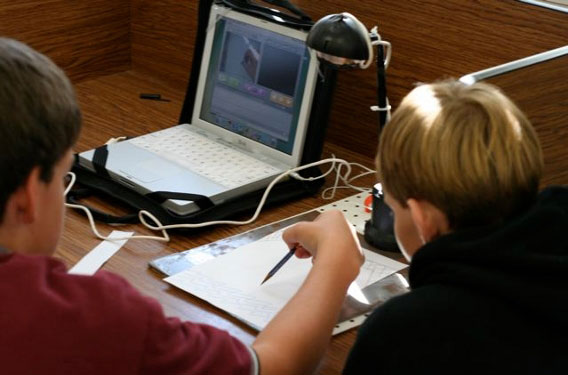Making the Next Wallace and Gromit
Stop-motion animation software developed at Tufts will get a wider audience with release of new kids’ book
By Marjorie Howard
A software program created by Tufts students, faculty and staff that allows kids to create their own animations is highlighted in the new Klutz Book of Animation. The software animation program, known as SAM Animation, was developed by the Center for Engineering Education and Outreach (CEEO) and is aimed at helping kids express their knowledge and ideas through a nontraditional medium.

The SAM Animation program was developed to give students a hands-on way to represent knowledge.
The Klutz Book of Animation is produced by Klutz Press and was recently published. It directs kids to download the demo version of SAM Animation to follow along in the activities highlighted in the book. The full version of SAM Animation can be purchased through Pitsco, an educational distribution company aimed at providing classroom resources for teachers.
The program was developed to give students a hands-on way to represent knowledge, says Melissa Pickering, assistant director of the CEEO. For instance, a child might understand how the digestive system works or what happens to molecules in water when it boils, but he may not be able to explain the concepts verbally or in writing. Using SAM Animation, the child can visually depict what he understands.
“If a child can create an animation to illustrate a topic, the teacher will have a clear idea of what the child understands about the concept,” says Pickering. Teachers are able to upload the movies their students produce to a gallery on the SAM Animation website.
SAM Animation took more than three years to develop, with significant classroom testing and teacher feedback. The majority of the development effort was funded by the National Science Foundation, and involved staff and graduate and undergraduate students within the CEEO, led by Brian Gravel, G11.
Klutz learned about the animation software while early beta versions were being offered online for free. The company was in the process of developing its animation book, and John Cassidy, the founder of Klutz, soon contacted the CEEO. “He said, ‘You have awesome software—is it OK if we use it as a tool in our next animation book?’ ” Pickering reports.
Because Klutz is using the publicly available demo version of the software, the CEEO is not receiving any licensing fees. Book owners are directed to a webpage that provides the option of downloading the demo software for free or purchasing the full version. “We’re anticipating that the visibility that Klutz will provide will cause a lot more people to purchase the software, and then we will get royalties,” Pickering says.
Purchasers of the software, which costs $49, also receive a teacher guide that includes sample animations and teacher testimonials on the variety of classroom applications. To use the software, a computer and a webcam are needed.
Marjorie Howard can be reached at marjorie.howard@tufts.edu.


